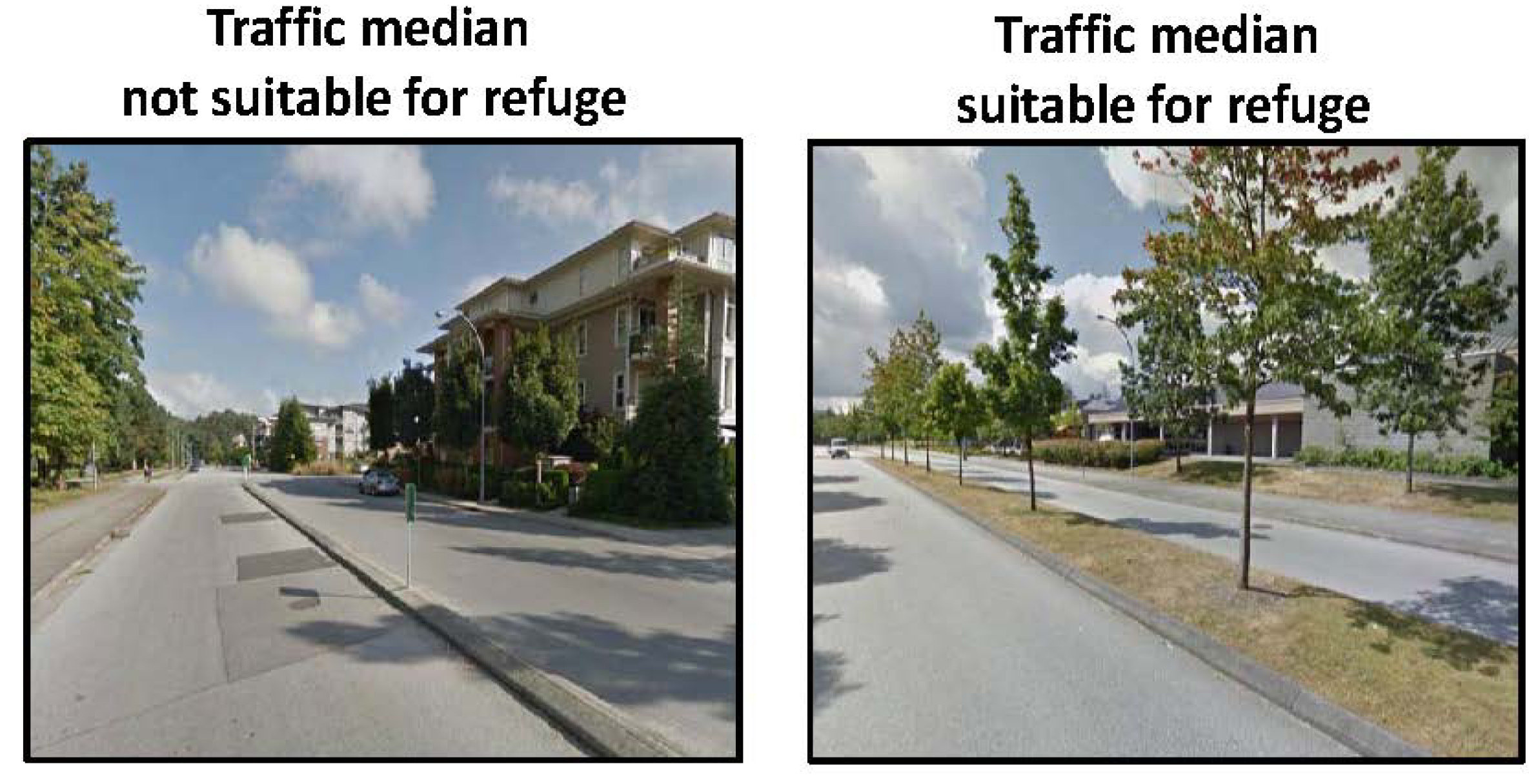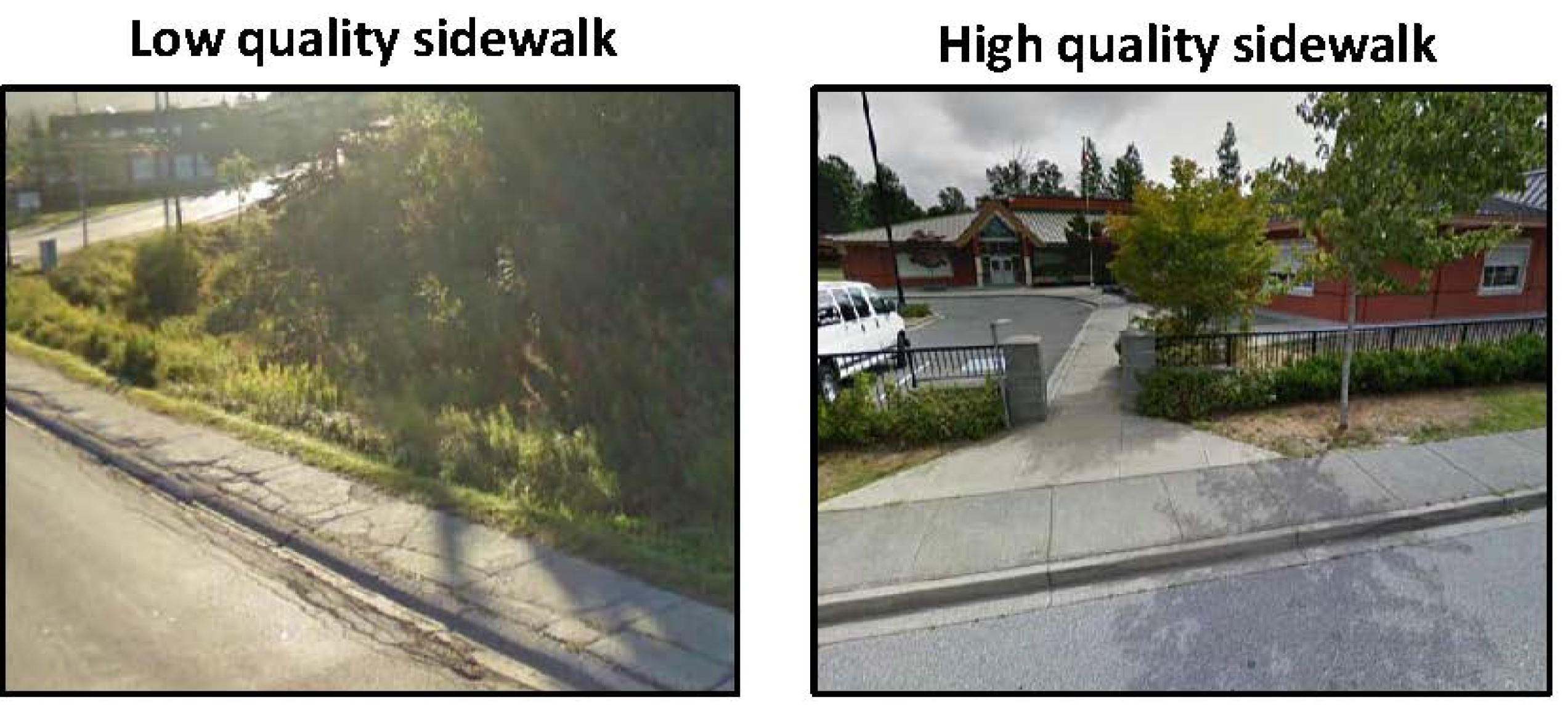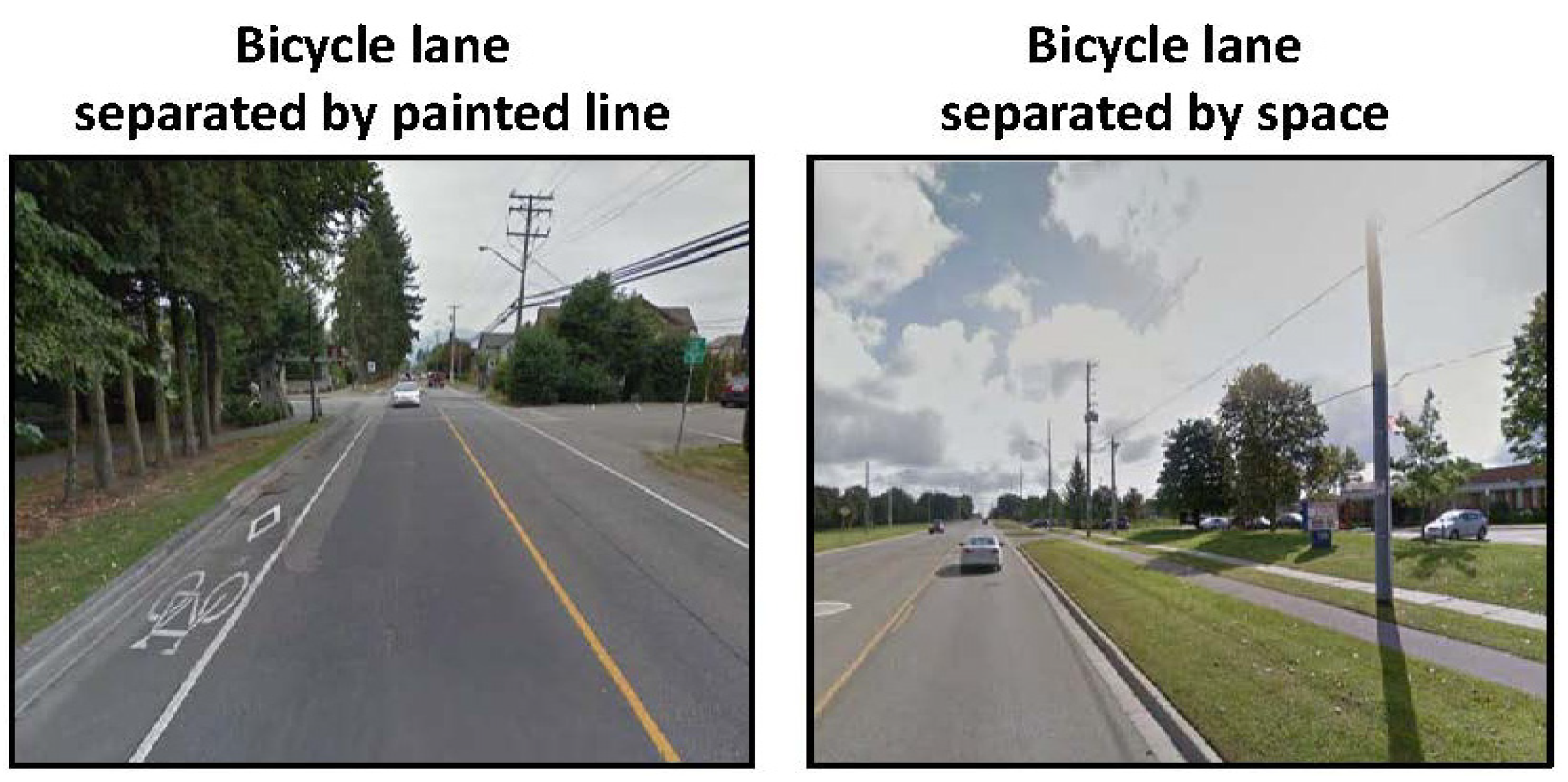Active Transportation Safety Features around Schools in Canada
Abstract
:1. Introduction
2. Methods
2.1. Survey Overview
2.2. GIS Measures




2.3. Administrator Survey Measures of Traffic Problems
2.4. Statistical Analysis
3. Results
4. Discussion and Conclusions
| Total | Urban/Rural Location of School | Type of School | ||||||||
|---|---|---|---|---|---|---|---|---|---|---|
| Rural | Small | Medium | Urban | p-Value | Primary | Mixed | Secondary | p-Value | ||
| Type of road (No. of schools with GIS) | 436 | 59 | 187 | 67 | 123 | 193 | 120 | 123 | ||
| Expressway, average% | 1.2 | 0.1 | 0.9 | 1.3 | 3.1 | 0.16 | 1.7 | 2.3 | 1.2 | 0.80 |
| Highway, average% | 6.0 | 11.3 | 6.5 | 4.8 | 2.4 | 5.1 | 4.5 | 5.1 | ||
| Major road, average% | 8.0 | 0.3 | 6.1 | 9.1 | 13.8 | 9.1 | 9.6 | 9.3 | ||
| Local road, average% | 84.8 | 88.3 | 86.5 | 84.8 | 80.6 | 84.0 | 83.7 | 84.4 | ||
| Distance across road (No. of schools with Google Earth) | 372 | 35 | 150 | 65 | 122 | 170 | 98 | 104 | ||
| Minimum (≤10 metres), % | 29.8 | 40.0 | 34.0 | 30.8 | 21.3 | 0.18 | 25.9 | 35.7 | 30.8 | 0.03 |
| Average (11 to 20 metres), % | 63.2 | 54.3 | 61.3 | 61.5 | 68.9 | 70.6 | 56.1 | 57.7 | ||
| Maximum (≥21 metres), % | 7 | 5.7 | 4.7 | 7.7 | 9.8 | 3.5 | 8.2 | 11.5 | ||
| Speed reduction sign near school (No. of schools with Google Earth) | 339 | 23 | 129 | 64 | 123 | 153 | 78 | 108 | ||
| Yes, % | 63.4 | 52.2 | 65.9 | 68.8 | 60.2 | 0.40 | 64.7 | 62.8 | 62.0 | 0.90 |
| Complete sidewalk coverage (No. of schools with Google Earth) | 404 | 44 | 173 | 64 | 123 | 181 | 110 | 113 | ||
| Yes, % | 85.1 | 59.1 | 76.9 | 98.4 | 99.2 | <0.001 | 86.7 | 73.7 | 93.8 | <0.001 |
| Presence of safety features (No. of schools with Google Earth) | 326 | 21 | 123 | 60 | 122 | 147 | 73 | 106 | ||
| Crosswalks not at intersections, % | 27.9 | 9.5 | 31.7 | 28.3 | 27.0 | 0.20 | 32.7 | 18.4 | 10.9 | 0.20 |
| Crosswalks at intersections, % | 81.0 | 0 | 75.6 | 93.3 | 89.3 | <0.001 | 84.4 | 80.2 | 75.3 | 0.28 |
| Proportions of intersections with crosswalks, % | 58.5 | 57.1 | 57.1 | 61.4 | 58.3 | 0.94 | 60.6 | 56.9 | 56.4 | 0.82 |
| Traffic median present, % | 30.0 | 4.8 | 22.0 | 35.0 | 40.2 | <0.001 | 23.8 | 34.2 | 35.8 | 0.13 |
| Traffic choker present, % | 5.5 | 0 | 4.1 | 5.0 | 9.0 | 0.15 | 5.5 | 0.9 | 6.6 | 0.78 |
| Speed bump present, % | 5.5 | 0 | 1.6 | 10.0 | 8.2 | 0.03 | 6.1 | 6.8 | 3.8 | 0.62 |
| Bicycle lane present, % | 10.1 | 0.2 | 6.2 | 7.5 | 10.7 | 0.25 | 8.8 | 6.5 | 8.5 | 0.28 |
| Total | Urban/Rural Location of School | Type of School | ||||||||
|---|---|---|---|---|---|---|---|---|---|---|
| Rural | Small | Medium | Urban | p-Value | Primary | Mixed | Secondary | p-Value | ||
| Crosswalks not at intersections (No. of schools with Google Street View) | 91 | 2 | 39 | 17 | 33 | 48 | 16 | 27 | ||
| Low quality, % | 17.6 | 50.0 | 7.7 | 7.4 | 33.3 | 0.19 | 18.8 | 0 | 25.9 | 0.10 |
| Moderate quality, % | 25.3 | 0 | 30.8 | 14.8 | 21.2 | 22.9 | 18.8 | 33.3 | ||
| High quality, % | 57.1 | 50.0 | 61.5 | 40.7 | 48.5 | 58.3 | 81.2 | 40.7 | ||
| Crosswalks at intersections (No. of schools with Google Street View) | 264 | 6 | 93 | 56 | 109 | 124 | 55 | 85 | ||
| Low quality, % | 30.7 | 33.3 | 24.7 | 17.9 | 42.2 | <0.001 | 40.3 | 29.1 | 35.5 | 0.36 |
| Moderate quality, % | 33.3 | 33.3 | 22.6 | 44.6 | 36.7 | 31.5 | 30.9 | 37.6 | ||
| High quality, % | 36.0 | 33.3 | 52.7 | 37.5 | 21.1 | 28.2 | 40.0 | 27.1 | ||
| Traffic medians (No. of schools with Google Street View) | 98 | 1 | 27 | 21 | 49 | 35 | 25 | 38 | ||
| Not suitable for refuge, % | 11.2 | 0 | 0 | 5.8 | 2.2 | 0.60 | 12.2 | 12.5 | 5.3 | 0.08 |
| Suitable for refuge, % | 88.8 | 100 | 100 | 84.2 | 87.8 | 87.8 | 87.5 | 94.7 | ||
| Sidewalk conditions (No. of schools with Google Street View) | 271 | 6 | 92 | 54 | 116 | 127 | 51 | 90 | ||
| Low quality, % | 1.1 | 0 | 1.9 | 0 | 0.9 | 0.65 | 0.8 | 1.9 | 1.1 | 0.82 |
| High quality, % | 98.9 | 100 | 97.9 | 100 | 99.1 | 99.2 | 98.1 | 99.9 | ||
| Bicycle lanes (No. of schools with Google Street View) | 32 | 0 | 11 | 9 | 12 | 12 | 11 | 9 | ||
| Separated by painted line, % | 81.3 | 0 | 63.6 | 77.8 | 100 | 0.08 | 83.3 | 81.1 | 77.8 | 0.95 |
| Separated by physical barrier or space, % | 18.8 | 0 | 36.4 | 22.2 | 0 | 16.7 | 18.2 | 22.2 | ||
| Total | Urban/Rural Location of School | Type of School | ||||||||
|---|---|---|---|---|---|---|---|---|---|---|
| Rural | Small | Medium | Urban | p-Value | Primary | Mixed | Secondary | p-Value | ||
| Traffic problems (No. of schools with administrative questionnaire) | 399 | 51 | 174 | 60 | 114 | 180 | 108 | 111 | ||
| Not a problem, % | 52.4 | 84.0 | 63.0 | 36.7 | 29.8 | <0.001 | 52.2 | 61.1 | 44.1 | 0.08 |
| Minor problem, % | 30.1 | 12.0 | 24.3 | 41.7 | 41.2 | 33.3 | 23.1 | 31.5 | ||
| Moderate problem, % | 13.5 | 4.0 | 9.8 | 18.3 | 21.1 | 12.2 | 12.0 | 17.1 | ||
| Major problem, % | 4.0 | 0 | 2.9 | 3.3 | 7.9 | 2.2 | 3.7 | 7.2 | ||
Acknowledgments
Conflicts of Interest
References
- Sallis, J.F.; Frank, L.D.; Saelens, B.E.; Kraft, M.K. Active transportation and physical activity: Opportunities for collaboration on transportation and public health research. Transp. Res. Pt. A-Policy Pract. 2004, 38, 249–268. [Google Scholar] [CrossRef]
- Handy, S.L.; Boarnet, M.G.; Ewing, R.; Killingsworth, R.E. How the built environment affects physical activity: Views from urban planning. Am. J. Prev. Med. 2002, 23, 64–73. [Google Scholar]
- Miranda-Moreno, L.F.; Morency, P.; El-Geneidy, A.M. The link between built environment, pedestrian activity and pedestrian—vehicle collision occurrence at signalized intersections. Accid. Anal. Prev. 2011, 43, 1624–1634. [Google Scholar] [CrossRef]
- Cervero, R.; Sarmiento, O.L.; Jacoby, E.; Gomez, L.F.; Neiman, A. Influences of built environments on walking and cycling: Lessons from Bogotá. Int. J. Sustain. Transp. 2009, 3, 203–226. [Google Scholar] [CrossRef]
- Winters, M.; Brauer, M.; Setton, E.M.; Teschke, K. Built environment influences on healthy transportation choices: Bicycling versus driving. J. Urban Health 2010, 87, 969–993. [Google Scholar] [CrossRef]
- Wang, C.; Quddus, M.A.; Ison, S.G. The effect of traffic and road characteristics on road safety: A review and future research direction. Saf. Sci. 2013, 57, 264–275. [Google Scholar] [CrossRef]
- Ameratunga, S. Editorial: Traffic speed zones and road injuries. BMJ. 2009, 339, p. b4743. [CrossRef]
- Sonkin, B.; Edwards, P.; Roberts, I.; Green, J. Walking, cycling and transport safety: An analysis of child road deaths. J. R. Soc. Med. 2006, 99, 402–405. [Google Scholar] [CrossRef]
- Kattan, L.; Tay, R.; Acharjee, S. Managing speed at school and playground zones. Accid. Anal. Prev. 2011, 43, 1887–1891. [Google Scholar] [CrossRef]
- Peden, M.; Oyegbite, K.; Ozanne-Smith, J.; Hyder, A.A.; Branche, C.; Fazlur Rahman, A.K.M.; Rivara, F.; Bartolomeos, K. World Report on Child Injury Prevention; World Health Organization: Geneva, Switzerland, 2008. [Google Scholar]
- Jones, S.J.; Lyons, R.A.; John, A.; Palmer, S.R. Traffic calming policy can reduce inequalities in child pedestrian injuries: Database study. Inj. Prev. 2005, 11, 152–156. [Google Scholar] [CrossRef]
- Dowswell, T.; Towner, E.M.; Simpson, G.; Jarvis, S.N. Preventing childhood unintentional injuries—what works? A literature review. Inj. Prev. 1996, 2, 140–149. [Google Scholar] [CrossRef]
- Ewing, R. Impacts of traffic calming. Transp. Quart. 2001, 55, 33–46. [Google Scholar]
- Schieber, R.A.; Vegega, M.E. Reducing childhood pedestrian injuries: Summary of a multi-disciplinary conference. Inj. Prev. 2002, 8 , (Suppl. I). i3–i8. [Google Scholar] [CrossRef]
- Sangowawa, A.O.; Adebiyi, A.O.; Faseru, B.; Popoola, O.J. An observational study of road safety around selected primary schools in Ibadan municipality, Oyo State, Southwestern Nigeria. Ann. Afr. Med. 2012, 11, 32–35. [Google Scholar] [CrossRef]
- Kweon, S.S.; Shin, M.H. An epidemiological study for child pedestrian traffic injuries that occurred in school-zone. J. Prev. Med. Public Health 2005, 38, 163–169. [Google Scholar]
- Von Kries, R.; Kohne, C.; Böhm, O.; von Voss, H. Road injuries in school age children: Relation to environmental factors amenable to interventions. Inj. Prev. 1998, 4, 103–105. [Google Scholar] [CrossRef]
- Kim, K.; Ozegovic, D.; Voaklander, D.C. Differences in incidence of injury between rural and urban children in Canada and the USA: A systematic review. Inj. Prev. 2012, 18, 264–271. [Google Scholar] [CrossRef]
- Currie, C.; Zanotti, C.; Morgan, A.; Currie, D.; de Looze, M.; Roberts, C.; Samdal, O.; Smith, O.; Barnekow, V. Social Determinants of Health and Well-Being among Young People. In Health Behaviour in School-Aged Children (HBSC) Study: International Report from the 2009/2010 Survey; World Health Organization Regional Office for Europe: Copenhagen, Denmark, 2012. [Google Scholar]
- O’Loghlen, S.; Pickett, W.; Janssen, I. Active transportation environments surrounding Canadian schools. Can. J. Public Health 2011, 102, 364–368. [Google Scholar]
- Janssen, I.; Rosu, A. Measuring sidewalk distances using Google Earth. BMC Med. Res. Methodol. 2012. [Google Scholar] [CrossRef]
- Engineering Facility Office of Design. Pedestrian Facility Design. In Highway Design Manual, 71st ed.Design Quality Assurance Bureau, New York State Department of Transportation: Albany, NY, USA, 2013; Chapter 18. [Google Scholar]
- Statistics Canada. From Urban Areas to Population Centres; Government of Canada: Ottawa, ON, Canada, 2011.
- Harris, M.A.; Reynolds, C.C.O.; Winters, M.; Cripton, P.A.; Shen, H.; Chipman, M.L.; Cusimano, M.D.; Babul, S.; Brubacher, J.R.; Friedman, S.M.; et al. Comparing the effects of infrastructure on bicycling injury at intersections and non-intersections using a case-crossover design. Inj. Prev. 2013. [Google Scholar] [CrossRef]
- Reynolds, C.C.; Harris, M.A.; Teschke, K.; Cripton, P.A.; Winters, M. The impact of transportation infrastructure on bicycling injuries and crashes: A review of the literature. Environ. Health 2009, 8, 47. [Google Scholar] [CrossRef]
- Haileyesus, T.; Annest, J.L.; Dellinger, A.M. Cyclists injured while sharing the road with motor vehicles. Inj. Prev. 2007, 13, 202–206. [Google Scholar] [CrossRef]
- Hunt, J.D.; Abraham, J.E. Influences on bicycle use. Transportation 2007, 34, 453–470. [Google Scholar] [CrossRef]
- Toroyan, T. Global Status Report on Road Safety 2013: Supporting a Decade of Action; World Health Organization: Geneva, Switzerland, 2013. [Google Scholar]
- DiMaggio, C.; Li, G. Roadway characteristics and pediatric pedestrian injury. Epidemiol. Rev. 2012, 34, 46–56. [Google Scholar] [CrossRef]
- Berthod, C. Traffic Calming—Speed Humps and Speed Cushions; 2011 Annual Conference of the Transportation Association of Canada: Ottawa, Canada, 2011. [Google Scholar]
- Transport Canada. Traffic Calming in Canadian Urban Areas. Urban. In Transportation Showcase Program. Case Studies in Sustainable Transportation. Case Study 35; Government of Canada: Ottawa, ON, Canada, 2005. [Google Scholar]
- Gropp, K.; Janssen, I.; Pickett, W. Active transportation to school in Canadian youth: Should injury be a concern? Inj. Prev. 2013, 19, 64–67. [Google Scholar] [CrossRef]
- Rothenberg, H.B.; Benavente, M.; Swift, J. Report on Passive Speed Control Devices. In Massachusetts Traffic Safety Research Program; Governor’s Highway Safety Bureau: Boston, MA, USA, 2004. [Google Scholar]
- Redmon, T. Safety Benefits of Walkways, Sidewalks, and Paved Shoulders; U.S. Department of Transportation, Federal Highway Administration: Washingston, DC, USA, 2010.
- Zegeer, C.; Stewart, J.; Huang, H.; Lagerway, P. Safety Effects of Marked vs. Unmarked Crosswalks at Uncontrolled Locations: Final Report and Recommended Guidelines. In Federal Highway Administration (FHWA); U.S. Department of Transportation: McLean, VA, USA, 2005; Rapport No. FHWA-HRT-04–100. [Google Scholar]
- Google Inc. Google Earth; Google: Mountain View, CA, USA, 2011. [Google Scholar]
- Canada’s Road Safety Strategy 2015; Canadian Council of Motor Transport Administrators: Ottawa, ON, Canada, 2011.
- Road Safety Canada Consulting. Road Safety in Canada; Public Health Agency of Canada: Ottawa, ON, Canada, 2011.
© 2013 by the authors; licensee MDPI, Basel, Switzerland. This article is an open access article distributed under the terms and conditions of the Creative Commons Attribution license (http://creativecommons.org/licenses/by/3.0/).
Share and Cite
Pinkerton, B.; Rosu, A.; Janssen, I.; Pickett, W. Active Transportation Safety Features around Schools in Canada. Int. J. Environ. Res. Public Health 2013, 10, 5711-5725. https://doi.org/10.3390/ijerph10115711
Pinkerton B, Rosu A, Janssen I, Pickett W. Active Transportation Safety Features around Schools in Canada. International Journal of Environmental Research and Public Health. 2013; 10(11):5711-5725. https://doi.org/10.3390/ijerph10115711
Chicago/Turabian StylePinkerton, Bryn, Andrei Rosu, Ian Janssen, and William Pickett. 2013. "Active Transportation Safety Features around Schools in Canada" International Journal of Environmental Research and Public Health 10, no. 11: 5711-5725. https://doi.org/10.3390/ijerph10115711




